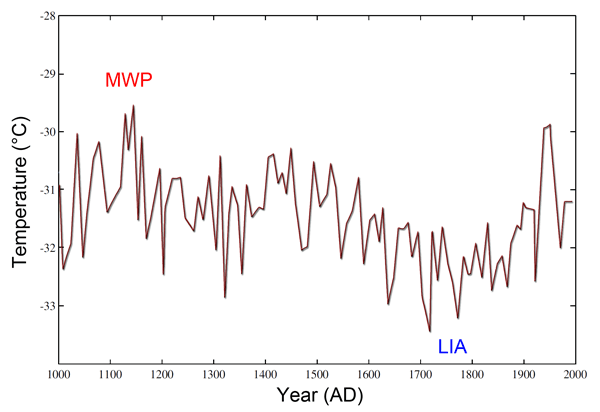Reference
Kobashi, T., Severinghaus, J.P., Barnola, J.-M., Kawamura, K., Carter, T. and Nakaegawa, T. 2010. Persistent multi-decadal Greenland temperature fluctuation through the last millennium. Climatic Change 100: 733-756.
Background
The authors write that "in Greenland, oxygen isotopes of ice (Stuiver et al., 1995) have been extensively used as a temperature proxy, but the data are noisy and do not clearly show multi-centennial trends for the last 1,000 years in contrast to borehole temperature records that show a clear 'Little Ice Age' and 'Medieval Warm Period' (Dahl-Jensen et al., 1998)." However, they note that nitrogen (N) and argon (Ar) isotopic ratios -- 15N/14N and 40Ar/36Ar, respectively -- can be used to construct a temperature record that "is not seasonally biased, and does not require any calibration to instrumental records, and resolves decadal to centennial temperature fluctuations."
What was done
Kobashi et al. describe the development of the new approach, after which they use it to construct a history of the last thousand years of central Greenland surface air temperature, based on values of isotopic ratios of nitrogen and argon previously derived by Kobashi et al. (2008) from air bubbles trapped in the GISP2 ice core that had been extracted from central Greenland (72°36'N, 38°30'W).
What was learned
The figure below depicts the central Greenland surface temperature reconstruction produced by the six scientists; and as best we can determine from this representation, the peak temperature of the latter part of the Medieval Warm Period -- which actually began some time prior to the start of their record, as demonstrated by the work of Dansgaard et al. (1975), Jennings and Weiner (1996), Johnsen et al. (2001) and Vinther et al. (2010) -- was approximately 0.33°C greater than the peak temperature of the Current Warm Period, and about 1.67°C greater than the temperature of the last decades of the 20th century. In addition, we note that between about 1400 and 1460 there was also a period of notable warmth in Kobashi et al.'s temperature reconstruction, which we have christened the "Little" Medieval Warm Period, the peak temperature of which was about 0.9°C greater than the temperature of the last decades of the 20th century and the first decade of the 21st century.

Central Greenland surface temperature reconstruction for the last millennium. Adapted from Kobashi et al. (2010).
What it means
The authors say their data "show clear evidence of the Medieval Warm Period and Little Ice Age in agreement with documentary evidence," and those data clearly show that the Medieval Warm Period was at times considerably warmer than the Current Warm Period has been to date, and that even the Little Medieval Warm Period was considerably warmer than it was over the last decades of the twentieth century, as well as the first decade of the 21st century. Thus, there is no compelling reason to believe that the 20th-century increase in the air's CO2 content (a 100-ppm rise above what it was during the warmer Medieval Warm Period) was the cause of 20th-century global warming, especially when climate alarmists claim that such warming, when it occurs, should be most evident and earliest expressed in high northern latitudes, and even more so in light of the fact that there is a millennial-scale climatic cycle that alternately brings the earth relatively warmer and cooler century-scale conditions throughout both glacial and interglacial periods alike (see Climate Oscillations -- Millennial Variability in our Subject Index).
References
Dahl-Jensen, D., Mosegaard, K, Gundestrup, N., Clew, G.D., Johnsen, S.J., Hansen, A.W. and Balling, N. 1998. Past temperatures directly from the Greenland ice sheet. Science 282: 268-271.
Dansgaard, W., Johnsen, S.J., Reech, N., Gundestrup, N., Clausen, H.B. and Hammer, C.U. 1975. Climatic changes, Norsemen and modern man. Nature 255: 24-28.
Jennings, A.E. and Weiner, N.J. 1996. Environmental change in eastern Greenland during the last 1300 years: evidence from foraminifera and lithofacies in Nansen Fjord, 68°N. The Holocene 6: 179-191.
Johnsen, S.J., Dahl-Jensen, D., Gundestrup, N., Steffensen, J.P., Clausen, H.B., Miller, H., Masson-Delmotte, V., Sveinbjörnsdottir, A.E. and White, J. 2001. Oxygen isotope and palaeotemperature records from six Greenland ice-core stations: Camp Century, Dye-3, GRIP, GISP2, Renland and NorthGRIP. Journal of Quaternary Science 16: 299-307.
Kobashi, T., Severinghaus, J.P. and Kawamura, K. 2008. Argon and nitrogen isotopes of trapped air in the GISP2 ice core during the Holocene epoch (0-11,600 B.P.): methodology and implications for gas loss processes. Geochimica et Cosmochimica Acta 72: 4675-4686.
Stuiver, M., Grootes, P.M. and Brazunias, T.F. 1995. The GISP2 δ18O climate record of the past 16,500 years and the role of the sun, ocean, and volcanoes. Quaternary Research 44: 341-354.
Vinther, B.M., Jones, P.D., Briffa, K.R., Clausen, H.B., Andersen, K.K., Dahl-Jensen, D. and Johnsen, S.J. 2010. Climatic signals in multiple highly resolved stable isotope records from Greenland. Quaternary Science Reviews 29: 522-538.
Reviewed 1 September 2010



